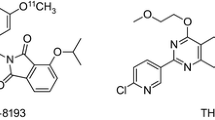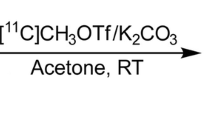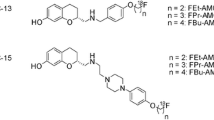Abstract
Purpose
Use of mGluR5 receptor radiotracers to determine whether an in vitro binding assay is able to predict how good a radiotracer is likely to be in imaging receptor in the central nervous system (CNS) via positron emission tomography (PET).
Procedures
Saturation and equilibrium competition studies in rat and rhesus membranes were used to determine receptor concentrations and tracer affinities. In addition, specific binding of metabotropic receptor subtype 5 (mGluR5) radioligands in rhesus and rat brain sections was determined using a “no-wash protocol,” and the in vivo binding signal in rats was determined using micro-PET.
Results
Affinity values were determined for a series of mGluR5 antagonists (1–5) and ranged from 0.1 to 11 nM in rat. A previously reported “no-wash protocol” was then employed to determine specific binding in tissue sections following a 20-min incubation, and the regional distribution of these mGluR5 radiotracers determined in rat brain via autoradiography. The analogs 1b, 2b, 3b, and 4b, but not 5b, displayed good signal-to-noise ratios under these conditions with high density of binding in caudate, cortex, and hippocampus and lower density in cerebellum. With this information it was predicted that 1c, 2c, 3b, and 4b would display measurable signal-to-noise ratios in vivo, and that the larger in vitro signals for 3b and 4b would translate to 3b and 4b yielding the best in vivo signals. These predictions were investigated using micro-PET imaging in rat. Compound 1c showed a rapid wash-in and rapid wash-out profile in rat brain. Compound 2c showed similar signal-to-noise ratio as 1b, but slower washout. Compounds 3b and 4b showed the best signal-to-noise ratio in vivo, while 5b did not provide a significant signal, as predicted. In vivo occupancy estimates for 2-methyl-6-(phenylethynyl)-pyridine (MPEP) following intravenous administration were determined using radiolabeled compounds 1c, 2c, and 3b; they were essentially the same and were on the order of 1 mg kg−1 (ID50).
Conclusions
An in vitro screen of several mGluR5 tracers was used to rapidly predict whether radiolabeled mGluR5 analogs would be useful as PET radiotracers. Results provided an extension to previously reported data. Two of the four radiotracers with the best in vitro “no-wash” results also showed the best potential as measured noninvasively using micro-PET.








Similar content being viewed by others
References
Patel S, Hamill T, Hostetler E, Burns HD, Gibson RE (2003) An in vitro assay for predicting successful imaging radiotracers. Mol Imaging Biol 5(2):6–71
Anwyl R (1999) Metabotropic glutamate receptors: Electrophysiological properties and role in plasticity. Brain Res Rev 29(1):83–120
Bordi F, Ugolini A (1999) Group I metabotropic glutamate receptors: Implications for brain diseases. Prog Neurobiol 59(1):55–79
Pin JP, Duvoisin R (1995) The metabotropic glutamate receptors: Structure and functions. Neuropharmacology 34:1–26
Knopfel T, Sakaki J, Allgeier H (1995) Metabotropic glutamate receptors: Novel targets for drug development. J Med Chem 38:1417–1426
Conn PJ, Pin JP (1997) Pharmacology and functions of Metabotropic glutamate receptors. Annu Rev Pharmacol Toxicol 37:205–237
Dogrul A, Ossipov MH, Lai J, Malan TP Jr, Porreca F (2000) Peripheral and spinal antihyperalgesic activity of SIB-1757, a metabotropic glutamate receptor (mGLUR5) antagonist, in experimental neuropathic pain in rats. Neurosci Lett 292:115–118
Ohnuma T, Tessler S, Arai H, Faull RLM, McKenna PJ, Emson PC (2000) Gene expression of metabotropic glutamate receptor 5 and excitatory amino acid transporter 2 in the schizophrenic hippocampus. Mol Brain Res 85(1–2):24–31
Moghaddam B (2002) Stress activation of glutamate neurotransmission in the prefrontal cortex: Implications for dopamine-associated psychiatric disorders. Biol Psychiatry 51:775–787
Millan MJ (2003) The neurobiology and control of anxious states. Prog Neurobiol 70(2):83–244
Greenamyre JT, Young AB (1989) Excitatory amino acids and Alzheimer's disease. Neurobiol Aging 10:593–602
Albin RL, Greenamyre JT (1992) Alternative excitotoxic hypotheses. Neurology 42:733–738
Rothman SM, Olney JW (1986) Glutamate and the pathophysiology of hypoxic–ischemic brain damage. Ann Neurol 19:105–111
Klimas MT (2002) Contributions to the understanding of pharmacokinetics, mechanism of action and disease state characterization. Mol Imaging Biol 4:311–337
Bergstrom M, Hargreaves RJ, Burns DH, Goldberg MR, et al. (2004) Human positron emission tomography studies of brain neurokinin 1 receptor occupancy by aprepitant. Biol Psychiatry 55:1007–1012
Hamill TG, Seiders TJ, Krause S, Ryan C, Sanabria S, Gibson RE, Patel S, Cosford N, Roppe J, Yang J, King C, Hargreaves RJ, Burns HD (2003) The synthesis and characterization of mGluR5 receptor PET ligands. J Label Compd Radiopharm 46(Suppl 1):S184
Krause SM, Hamill TG, Seiders TJ, Ryan C, Sanabria S, Gibson RE, Patel S, Cosford ND, Roppe JR, Hargreaves RJ, Burns HD (2003) In vivo characterization of PET ligands for the mGLuR5 receptor in rhesus monkey. Mol Imaging Biol 5:166
Gasparini F, Lingenhohl K, Stoehr N, Flor PJ, Heinrich M, Vranesic I, Biollaz M, Allgeier H, Heckendorn R, Urwyler S, Varney MA, Johnson EC, Hess SD, Rao SP, Sacaan AI, Santori EM, Velicelebi G, Kuhn R (1999) 2-Methyl-6-(phenylethynyl)-pyridine (MPEP), a potent. Selective and systemically active mGlu5 receptor antagonist. Neuropharmacology 38:1493–1503
Hamill TG, Krause S, Ryan C, Bonnefous C, Govek S, Seiders J, Cosford NDP, Roppe J, Kamanecka T, Patel S, Gibson RE, Sanabria S, Riffel KA, Eng W, King C, Yang X, Green MD, O'Malley S, Hargreaves RJ, Burns HD (2005) The synthesis, characterization and first successful monkey imaging studies of metabotropic glutamate receptor subtype 5 (mglur5) pet radiotracers. Synapse (in press)
Patel S, Krause SM, Hamill T, Chaudhary A, Burns HD, Gibson RE (2003b) In vitro characterization of [3H[methoxyPyEP, an mGluR5 selective radioligand. Life Sci 73:371–379
Bradford MM (1976) A rapid and sensitive method for the quantitation of microgram quantities of protein utilizing the principal of protein–dye binding. Anal Biochem 72:248–254
Eckleman WC, Gibson RE (1992) The design of site-directed radiopharmaceuticals for use in drug discovery. In: Burns H, Gibson R, Dannals R et al. (eds) Nuclear imaging in drug discovery, development and approval. Birkhauser, Boston, pp. 113–134
Katzenellenbogen JA, Heiman DF, Carlson KE, Lloyd JE (1981) In vitro and in vivo steroid receptor assays in the design of estrogen radiopharmaceuticals. In: Eckelman WC (ed) Receptor binding radiotracers, vol 1. CRC Press, Boca Raton
Gupta N, Price PM, Aboagye EO (2002) PET for in vivo pharmacokinetic and pharmacodynamic measurements. Eur J Cancer 38:2094–2107
Author information
Authors and Affiliations
Corresponding author
Rights and permissions
About this article
Cite this article
Patel, S., Ndubizu, O., Hamill, T. et al. Screening Cascade and Development of Potential Positron Emission Tomography Radiotracers for mGluR5: In vitro and In vivo Characterization. Mol Imaging Biol 7, 314–323 (2005). https://doi.org/10.1007/s11307-005-0005-4
Published:
Issue Date:
DOI: https://doi.org/10.1007/s11307-005-0005-4




